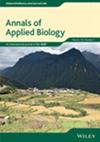求助PDF
{"title":"在干旱胁迫下,哈茨真菌提高大豆和蚕豆根部生物量的产生并促进侧根生长","authors":"Marina E. Battaglia, Sergio I. Martinez, Fernanda Covacevich, Verónica F. Consolo","doi":"10.1111/aab.12909","DOIUrl":null,"url":null,"abstract":"<p>Drought stress (DS) is one of the main environmental stresses that determines crop productivity. It has been estimated that DS depresses over 40%–60% of soybean (<i>Glycine max</i> (L.) Merr.) and common bean (<i>Phaseolus vulgaris</i> L.) production worldwide, respectively. Although different agronomic strategies are sometimes implemented, the current goal in sustainable agriculture could involve the inoculation with native microorganisms to mitigate DS effects. A potential fungal candidate is <i>Trichoderma</i>, which is recognized as a ubiquitous soil inhabitant with growth-promoting and biocontrol potentiality. However, its potential for mitigating the stress for water deficit is less well-documented. Our objective was to evaluate the effect of inoculation with native <i>Trichoderma harzianum</i> strains on soybean and common bean growth under contrasting conditions of water availability. Seeds were independently inoculated (or not) with IB-J15 and IB-363 strains, and plants were submitted to DS or were kept under optimal irrigation (well-watered, WW). In both legumes, the most evident effect after being inoculated was the modification of plant root architecture, the increase in root area and the development of lateral roots in plants under WW and DS conditions. In soybean, both <i>Trichoderma</i> strains had a positive inoculation response, both fresh and dry root biomass increased under WW, and remarkably under DS conditions. The main effect was an increase of about 110% in root dry weight under WW and, about 330% in DS in plants inoculated with IB-J15 strain, meanwhile, plants inoculated with IB-363 increased root dry weight 60% in WW and 177% in DS conditions. Notably in soybean, the inoculation with both <i>Trichoderma</i> strains increased the root area more than 70% in both WW and DS conditions. Common beans inoculated with IB-363 under WW conditions, reached a positive inoculation responsiveness of around 247% in shoot dry weight biomass, and under WW both strains increased the root area more than 50%. Further, IB-363 increased leaf area by 25% in WW and 72% in DS. Additionally, the in vitro co-culture between both <i>Trichoderma</i> strains and nodulating <i>Rhizobium etli</i> and <i>Bradyrhizobium japonicum</i> E109 showed compatibility between microorganisms, since no inhibition of their growth was observed. We emphasize that plants inoculated with <i>Trichoderma</i> showed better resistance to water deficit, as seen by redistribution of photosynthates, prioritizing mainly, the development of the root system. © 2024 Association of Applied Biologists.</p>","PeriodicalId":7977,"journal":{"name":"Annals of Applied Biology","volume":"185 1","pages":"36-48"},"PeriodicalIF":2.2000,"publicationDate":"2024-05-01","publicationTypes":"Journal Article","fieldsOfStudy":null,"isOpenAccess":false,"openAccessPdf":"","citationCount":"0","resultStr":"{\"title\":\"Trichoderma harzianum enhances root biomass production and promotes lateral root growth of soybean and common bean under drought stress\",\"authors\":\"Marina E. Battaglia, Sergio I. Martinez, Fernanda Covacevich, Verónica F. Consolo\",\"doi\":\"10.1111/aab.12909\",\"DOIUrl\":null,\"url\":null,\"abstract\":\"<p>Drought stress (DS) is one of the main environmental stresses that determines crop productivity. It has been estimated that DS depresses over 40%–60% of soybean (<i>Glycine max</i> (L.) Merr.) and common bean (<i>Phaseolus vulgaris</i> L.) production worldwide, respectively. Although different agronomic strategies are sometimes implemented, the current goal in sustainable agriculture could involve the inoculation with native microorganisms to mitigate DS effects. A potential fungal candidate is <i>Trichoderma</i>, which is recognized as a ubiquitous soil inhabitant with growth-promoting and biocontrol potentiality. However, its potential for mitigating the stress for water deficit is less well-documented. Our objective was to evaluate the effect of inoculation with native <i>Trichoderma harzianum</i> strains on soybean and common bean growth under contrasting conditions of water availability. Seeds were independently inoculated (or not) with IB-J15 and IB-363 strains, and plants were submitted to DS or were kept under optimal irrigation (well-watered, WW). In both legumes, the most evident effect after being inoculated was the modification of plant root architecture, the increase in root area and the development of lateral roots in plants under WW and DS conditions. In soybean, both <i>Trichoderma</i> strains had a positive inoculation response, both fresh and dry root biomass increased under WW, and remarkably under DS conditions. The main effect was an increase of about 110% in root dry weight under WW and, about 330% in DS in plants inoculated with IB-J15 strain, meanwhile, plants inoculated with IB-363 increased root dry weight 60% in WW and 177% in DS conditions. Notably in soybean, the inoculation with both <i>Trichoderma</i> strains increased the root area more than 70% in both WW and DS conditions. Common beans inoculated with IB-363 under WW conditions, reached a positive inoculation responsiveness of around 247% in shoot dry weight biomass, and under WW both strains increased the root area more than 50%. Further, IB-363 increased leaf area by 25% in WW and 72% in DS. Additionally, the in vitro co-culture between both <i>Trichoderma</i> strains and nodulating <i>Rhizobium etli</i> and <i>Bradyrhizobium japonicum</i> E109 showed compatibility between microorganisms, since no inhibition of their growth was observed. We emphasize that plants inoculated with <i>Trichoderma</i> showed better resistance to water deficit, as seen by redistribution of photosynthates, prioritizing mainly, the development of the root system. © 2024 Association of Applied Biologists.</p>\",\"PeriodicalId\":7977,\"journal\":{\"name\":\"Annals of Applied Biology\",\"volume\":\"185 1\",\"pages\":\"36-48\"},\"PeriodicalIF\":2.2000,\"publicationDate\":\"2024-05-01\",\"publicationTypes\":\"Journal Article\",\"fieldsOfStudy\":null,\"isOpenAccess\":false,\"openAccessPdf\":\"\",\"citationCount\":\"0\",\"resultStr\":null,\"platform\":\"Semanticscholar\",\"paperid\":null,\"PeriodicalName\":\"Annals of Applied Biology\",\"FirstCategoryId\":\"97\",\"ListUrlMain\":\"https://onlinelibrary.wiley.com/doi/10.1111/aab.12909\",\"RegionNum\":3,\"RegionCategory\":\"农林科学\",\"ArticlePicture\":[],\"TitleCN\":null,\"AbstractTextCN\":null,\"PMCID\":null,\"EPubDate\":\"\",\"PubModel\":\"\",\"JCR\":\"Q2\",\"JCRName\":\"AGRICULTURE, MULTIDISCIPLINARY\",\"Score\":null,\"Total\":0}","platform":"Semanticscholar","paperid":null,"PeriodicalName":"Annals of Applied Biology","FirstCategoryId":"97","ListUrlMain":"https://onlinelibrary.wiley.com/doi/10.1111/aab.12909","RegionNum":3,"RegionCategory":"农林科学","ArticlePicture":[],"TitleCN":null,"AbstractTextCN":null,"PMCID":null,"EPubDate":"","PubModel":"","JCR":"Q2","JCRName":"AGRICULTURE, MULTIDISCIPLINARY","Score":null,"Total":0}
引用次数: 0
引用
批量引用


